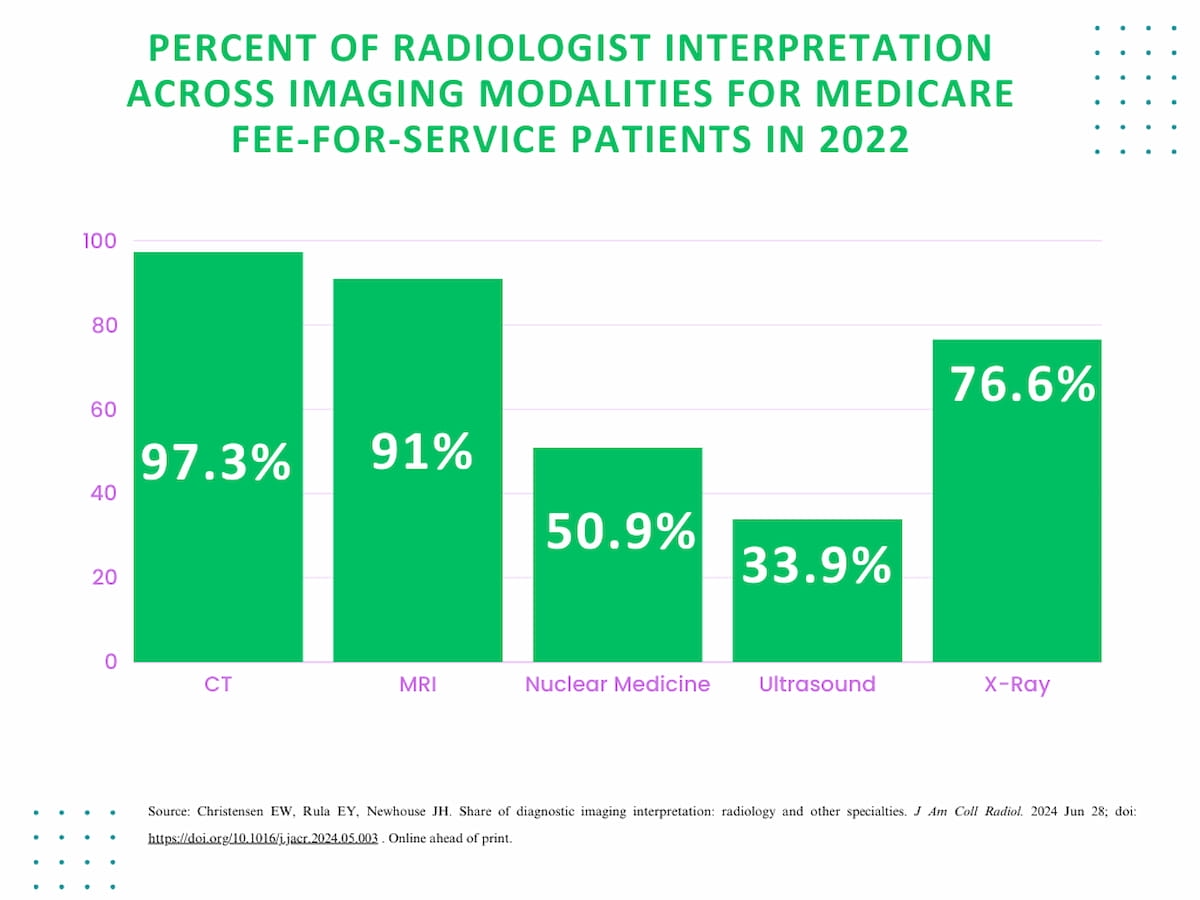Non-radiologists interpreted over 34 million imaging studies for Medicare fee-for-service beneficiaries in 2022, accounting for 27.9 percent of imaging performed in this patient population, according to new research.
For the study, recently published in the Journal of the American College of Radiology (JACR), researchers reviewed 2022 data from the Physician/Supplier Procedure Summary (PSPS) for 122,851,716 imaging studies performed for Medicare fee-for-service patients.
The study authors found that radiologists interpreted 72.1 percent (88,559,272) of those imaging studies. While radiologists interpreted the vast majority of computed tomography (CT) (97.3 percent) and magnetic resonance (MR) scans (91 percent), the researchers noted significantly lower percentages of radiologist interpretation for ultrasound (33.9 percent) and nuclear medicine (NM) (50.9 percent).
The researchers also pointed out that 23.4 percent of X-rays were interpreted by non-radiologists.
“Why imaging interpretation patterns across specialties have evolved as they have is likely multifaceted but may include the financial viability of (non-radiologists’) in house-imaging practice through self-referral, differences between radiologists and (non-radiologists) regarding the sources of their patients, centralization of in-hospital imaging interpretation, modality-specific capacities to limit images to specific anatomic regions, and imaging education and training,” wrote Eric W. Christensen, Ph.D., the director of economic and health services research at the Harvey L. Nieman Health Policy Institute in Reston, Virginia, and colleagues.
For non-cardiac imaging, the researchers noted that radiologists interpreted 97.6 percent of CT exams, 91.4 percent of MR scans and 95.6 percent of NM imaging. However, for cardiac imaging, they found that radiologist interpretation was 30 percent lower for CT (67.6 percent), 48.9 percent lower for MR (42.2 percent) and 83.7 percent lower for NM scans (11.8 percent).
The study authors also pointed out lower rates of radiologist interpretation for non-cardiac studies in the office setting (84.4 percent for CT, 85.4 percent for NM and 78.7 percent for MR) in comparison to hospital and emergency department settings (99.5 percent for CT, 98.9 percent for NM and 99.4 percent for MR).
Three Key Takeaways
1. Higher radiology interpretation rates for CT and MR but lower involvement with other imaging modalities. In 2022, radiologists interpreted 72.1 percent of imaging studies for Medicare fee-for-service beneficiaries with particularly high interpretation rates for CT (97.3 percent) and MR scans (91 percent). However, their involvement was significantly lower for ultrasound (33.9 percent) and nuclear medicine (50.9 percent).
2. Significant role of non-radiologists for certain modalities. Non-radiologists interpreted 27.9 percent of imaging studies overall. They also had significant involvement in interpreting X-rays (23.4 percent), ultrasound images (66.1 percent) and nuclear medicine scans (49.1 percent).
3. Variation in radiologist interpretation by setting and modality. Radiologists interpreted nearly all non-cardiac CT, MR, NM, and XR studies in hospital outpatient, inpatient, and emergency department settings. However, their involvement was lower for non-cardiac imaging in office settings (84.4 percent for CT, 85.4 percent for NM, and 78.7 percent for MR) compared to hospital settings.
Noting that hospitals receive the technical component revenue for imaging performed at hospitals as imaging equipment is generally owned and overseen by hospitals, the researchers said centralized imaging with radiologists has been linked with improved quality, turnaround time and impact on patient care.
“Such centralization of imaging into a hospital imaging department is consistent with the finding that radiologists interpret nearly all CT, MR, NM, and XR and four-fifths of ultrasound studies in the hospital outpatient, inpatient, and emergency department places of service,” noted Christensen and colleagues.
(Editor’s note: For related content, see “Current Perspectives on Radiology Workforce Issues and Potential Solutions,” “Medicare Claims Study Shows Increasing Utility of PAs and NPs in Radiology Practices” and “Can Short-Term Measures Provide Some Relief with the Radiologist Shortage?”)
In regard to study limitations, the authors acknowledged that the study’s focus on Medicare fee-for-service beneficiaries limits extrapolation of the study findings to broader populations. They also conceded the percentages of radiologist interpretation for different forms of imaging may be different for Medicaid patients or those who have Medicare Advantage. For patients with Medicaid or commercial health-care insurance, the researchers indicated the likelihood of significant differences in the percentages of ultrasound interpretation by gynecologists and obstetric physicians.
